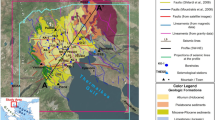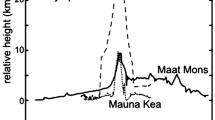Abstract
We present the electrical resistivity model along a profile perpendicular to the Middle America trench in southern Mexico that reveals previously unrecognized tectonic features at upper to mid-crustal depths. Our results support the hypotheses that the upper crust of the Oaxaca terrane is a residual ~20 km thick crust composed by an ~10 km thick faulted crustal upper layer and an ~10 km thick hydrated and/or mineralized layer. Oaxaca basement overthrust the younger Juárez (or Cuicateco) terrane. The electrical resistivity model supports the interpretation of a slab subducting at a low angle below Oaxaca. Uplift in the Oaxaca region appears to be related to fault reactivation induced by low angle subduction. In the Juárez terrane, isostatic forces may contribute to uplift because it is largely uncompensated. In the Sierra Madre del Sur, closer to the coast, uplift is facilitated by slab-dehydration driven buoyancy. Both gravity and resistivity models are consistent with a thinned upper crust in the northeast end of the profile.






Similar content being viewed by others
References
Alaniz–Álvarez, S.A., Nieto-Samaniego, A.F., and Ortega-Gutiérrez, F. (1994), Structural evolution of the Sierra Juárez mylonitic complex, state of Oaxaca, Mexico, Revista Mexicana de Ciencias Geológicas 1, 147–156.
Alaniz-Alvarez, S.A., Van Der Heyden, P., Nieto Samaniego, A.F., and Ortega-Gutiérrez, F. (1995), Radiometric and kinematic evidence for Middle Jurassic strike-slip faulting in southern Mexico related to the opening of the Gulf of Mexico, Geology 24 (5), 443–446.
Ángeles Moreno, E., (2006) Petrografía, geología estructural y geocronología del borde noroccidental del terreno Cuicateco, sierra Mazateca, estado de Oaxaca, México, M.Sc. Thesis, Universidad Nacional Autónoma de México (Ciudad de México, 2006)
Arzate J., Mareschal M., and Livelybrooks D. (1995), Electrical image of the subducting Cocos plate from magnetotelluric observations, Geology 23 (8), 703–706.
Bandy, W., Kostoglodov V., Hurtado-Díaz A., and Mena M. (1999), Structure of the southern Jalisco subduction zone, Mexico, as inferred from gravity and seismicity, Geofís. Internacional 38, 127–136.
Barboza Gudiño, R. (1996), Contribución a la geología de la Sierra de Juárez en el sur de México, Zentralblatt für Geologie und Paläontologie, Teil 1 (1994 H. 7/8), 991–1005.
Blakely R., Brocher T. and Wells R. (2005), Subduction-zone magnetic anomalies and implications for hydrated forearc mantle, Geology 33 (6), 445–448.
Bostick, F.X. (1977), A simple almost exact method of magnetotelluric analysis. In: Ward, S. (ed.), Workshop of Electrical Methods in Geothermal Exploration, Univ. of Utha, Res. Inst., U.S. Geol. Surv., contract N° 14080001-8-359.
Brasse, H., Lezaeta, P., Rath, V., Schwalenberg, K., Soyer, W. and Haak, V. (2002), The Bolivian Altiplano conductivity anomaly, J. Geophys. Res. 107, 3 (1–14).
Brasse, H., Kapinos, G., Mütschard, L., Alvarado, G.E., Worzewski, T., and Jegen, M., (2008), Deep electrical resistivity structure of northwestern Costa Rica. Geophys. Res. Lett. 36 (2), L02310 (1–5).
Brudzinski, M., Hinojosa Prieto, H., Schlanser, K. M., Cabral Cano, E., Arciniega Ceballos, A., Díaz Molina, O., and DeMets, C. (2010), Nonvolcanic tremor along the Oaxaca segment of the Middle America subduction zone, Journal of Geophys. Res. 115, B00A23 (1–15).
Caldwell, T. G., Bibby, H. M., and Brown, C. (2004), The Magnetotelluric Phase Tensor, Geophys. Journal Int. 158, 457–469.
Campa, M.F., and Coney, P.J. (1983), Tectono-stratigraphic terranes and mineral resource distributions in Mexico, Canadian Journal of Earth Sciences 20, 1040–1051.
Campos-Enriquez, J.O., Corbo-Camargo, F., Arzate-Flores J., Keppie J.D., Arango-Galván, C., Unsworth, M., and Belmonte-Jiménez S.I. (2013), The buried southern continuation of the Oaxaca-Juarez terrane boundary and Oaxaca Fault, southern Mexico: magnetotelluric constraints, J. South Am. Earth Sci. 43, 62–73.
Carfantán, J.C., (1986) Du systeme cordilleran nord-américain au domaine Caraibe - Étude géologique du Mexique meridional. PhD. Thesis. Chambérym Université de Savoie, (Savoie, France, 1986).
Centeno García, E., (1988) Evolución estructural de la falla de Oaxaca durante el Cenozoico. M.S. Thesis, Universidad Nacional Autónoma de México, (Ciudad de México, México, 1988).
Corbo, F. (2013), Estudio de la subducción y su relación con la presencia de fluidos a partir de sondeos magnetotelúricos en el Bloque de Jalisco y Oaxaca. PhD. Thesis. Centro de Geociencias, Universidad Nacional Autónoma de México, (Ciudad de México, México).
Dávalos-Álvarez, O.G., Nieto Samaniego, A.F., Alaniz Álvarez, S.A., Martínez Hernández, E. and Ramírez Arriaga, E. (2007), Estratigrafía cenozoica de la región de Tehuacán y su relación con el sector norte de la falla de Oaxaca, Revista Mexicana de Ciencias Geológicas 24, 197–215.
Ducea, M. N., Gehrels, G. E., Shoemaker, S., Ruiz, J., and Valencia, V. A. (2004), Geologic evolution of the Xolapa Complex, southern Mexico: Evidence from U-Pb zircon geochronology, GSA Bulletin 116 (7-8), 1016–1025.
Elías Herrera, M., and Ortega Gutiérrez, F. (2002), Caltepec fault zone: An Early Permian dextral transpressional boundary between the Proterozoic Oaxacan and Paleozoic Acatlán complexes, southern Mexico, and regional tectonic implications, Tectonics 21, 4 (1–18).
Ferrari, L., Orozco-Esquivel, T., Manea, V., and Manea, M. (2012), The dynamic history of the Trans-Mexican Volcanic Belt and the Mexico subduction zone, Tectonophysics 522–523, 122–149.
Grajales Nishimura, J.M., Centeno-Garciaa, E., Keppiea, J.D., and Dostal, J. (1999), Geochemistry of Paleozoic basalts from the Juchatengo complex of southern Mexico: tectonic implications, Journal of South American Earth Sciences 12, 537–544.
Green, C. M., Fairhead J. D., and Maus D. S. (1998), Satellite-derived gravity: Where we are and what’s next, The Leading Edge 17, 77–79.
Hyndman, R.D., and Shearer, P.M. (1989), Water in the lower continental crust: modelling magnetotelluric and seismic reflection results, Geophysical Journal International 98 (2), 343–365.
Jödicke, H., Jording A., Ferrari L., Arzate J., Mezger K., and Rüpke L. (2006), Fluid release from the subducted Cocos plate and partial melting of the crust deduced from magnetotelluric studies in southern Mexico: Implications for the generation of volcanism and subduction dynamics, J. Geophys Res. 111, B08102 (1–22).
Jones A. G. (1983), On the equivalence of the Niblett and Bostick transformations in the magnetotelluric method, J. Geophys Prosp. 14, 72–73.
Jording A., Ferrari L., Arzate J., and Jodicke H. (2000), Crustal variations and terrane boundaries in southern Mexico as imaged by magnetotelluric transfer functions, Tectonophysics 327, 1–13.
Kurtz R.D., Delaurier J.M., and Gupta, J.C. (1986), A magnetotelluric sounding across Vancouver Island detects the subducting Juan de Fuca plate, Nature 321, 596–599.
Kurtz, R.D., Delaurie, J.M., and Gupta, J.C. (1990), The electrical conductivity distribution beneath Vancouver Island: A region of active plate subduction, J. Geophys. Res. 95, 10929–10946.
Manea, M., and Manea, V.C. (2010), Curie Point Depth Estimates and Correlation with Subduction in Mexico, Pure and Applied Geophysics 168 (8), 1489–1499.
Manea, V.C., Manea, M., and Ferrari, L. (2013), A geodynamical perspective on the subduction of Cocos and Rivera plates beneath Mexico and Central America, Tectonophysics 609, 56–81.
Mendoza-Rosales C.C., Centeno-García E., Silva-Romo G., Campos-Madrigal E., and Bernal J.P. (2009), Barremian rift-related turbidites and alkaline volcanism in southern Mexico and their role in the opening of the Gulf of Mexico, Earth and Planetary Science Letters 295, 419–434.
Molina Garza, R.S., Geissman, J.W., Wawtzyniec, T.F., Peña Alonso, T.A., Iriondo, A., Weber, B., and Aranda-García, J.J. (2015), Geology of the coastal Chiapas (Mexico) Miocene plutons and the Tonalá shear zone: Syntectonic emplacement and rapid exhumation during sinistral transpression, Lithosphere 7 (8), 257–274.
Morán-Zenteno, D. J., Corona-Chávez, P., and Tolson, G. (1996), Uplift and subduction erosion in southwestern Mexico since the Oligocene: pluton geobarometry constraints, Earth and Planetary Science Letters 141, 51–65.
Niblett E. R., and Sayn-Wittgenstein C. (1960), Variation of electrical conductivity with depth by the magneto-telluric method, Geophysics 25 (5), 998–1008.
Nieto-Samaniego A.F., Alaniz-Alvarez S.A., Silva-Romo G., Eguiza-Castro M.H., and Mendoza-Rosales C.C. (2006), Latest Cretaceous to Miocene deformation events in the eastern Sierra Madre del Sur, Mexico, inferred from the geometry and age of major structures, GSA bulletin 118 (1–2), 238–252.
Ortega-Gutiérrez F. (1981), Metamorphic belts of southern Mexico and their tectonic significance, Geofísica Internacional 20, 177–202.
Ortega Gutiérrez, F., Mitre-Salazar, L.M., Roldán-Quintana, J., Sánchez-Rubio, G., and De la Fuente, M. (1990), North American Continent-Ocean Transect Program, Transect H-3 – Acapulco Trench to the Gulf of Mexico across southern Mexico, Geological Society of America, Decade of North American Geology Program, scale 1:500000, (México).
Ortega-Gutiérrez F., Elias Herrera M., and Elizondo Dávalos M. G. (2008), On the nature and role of the lower crust in the volcanic front of the Trans-Mexican Volcanic Belt and its fore-arc region, southern and central México, Revista Mexicana de Ciencias Geológicas 25 (002), 346–364.
Pardo M., and Suarez G. (1995), Shape of the subducted Rivera and Cocos plates in southernMexico: Seismic and tectonic implications, J. Geophys Res. 100, 12,357–12,373.
Peacock S.M. (1990), Fluid Processes in Subduction Zones, Science 248, 329–337.
Rodi W., and Mackie R. (2001), Nonlinear conjugate gradients algorithm for 2-D magnetotelluric inversion, Geophysics 66 (1), 174–187.
Sandwell, D.T., and Smith W. H. (1997), Marine gravity anomaly from Geosat and ERS 1 satellite altimetry, J. Geophys. Res. 102, 10039–10054.
Sandwell D. T. and Smith W. H. (2009), Global marine gravity from retracked Geosat and ERS-1 altimetry: Ridge segmentation versus spreading rate, J. Geophys Res. 114, B01411 (1–18).
Schaaf, P., Morán-Zenteno, D., Hernández-Bernal, M., Solís-Pichardo, G., Tolson, G., and Köhler, H. (1995), Paleogene continental margin truncation in southwestern Mexico, Geochronological evidence: Tectonics 14, 1339–1350.
Schmidt M. W., and Poli S. (1998), Experimentally based water budgets for dehydrating slabs and consequences for arc magma generation, Earth and Planetary Sc. Letters 163, 361–379.
Schwarz G., and Krüger D. (1997), Resistivity cross section through the Southern Central Andean Crust as inferred from 2-D modelling of magnetotelluric and geomagnetic deep sounding measurements, J. Geophys Res. 102 (B6), 11957–11978.
Solari, L.A., Torres de León, R., Hernández Pineda, G., Solé, J., Solís-Pichardo, G., and Hernández-Treviño, T. (2007), Tectonic significance of Cretaceous–Tertiary magmatic and structural evolution of the northern margin of the Xolapa Complex, Tierra Colorada area, southern Mexico, Geological Society of America Bulletin 119, 1265–1279.
Spranger, W.J. (1994), M. GEOLIMEX: Eine erste Geotraverse durch Sudmexiko; Auswertung des refraktions seismischen Profils, PhD. Thesis, Christian-Albrechts University, (Kiel, Germany).
Talavera-Mendoza, O., Ruiz, J., Corona-Chavez, P., Gehrels, G.E., Sarmiento-Villagrana, A., García-Díaz, J.L., and Salgado-Souto, S.A. (2013), Origin and provenance of basement metasedimentary rocks from the Xolapa Complex: New constraints on the Chortis–southern Mexico connection, Earth and Planetary Science Letters 369, 188–199.
Talwani, M., J. L. Worzel., and Landisman, M. (1959), Rapid gravity computations for two-dimensional bodies with applications to the Mendocino submarine fracture zone, J. Geophys. 64, 49–59.
Tatsumi Y., and Eggins S. (1990), Subduction Zone Magmatism (Oxford, England).
Valdes, C.M., Mooney, W. D., Singh, S. K., Meyer, R. P., Lomnitz, C., Luetgert, J. H., Helsley, C. E., Lewis, B. T. R., and Mena, M. (1986), Crustal structure of Oaxaca, Mexico, from seismic refraction measurements, Bulletin of the Seismological Society of America 76, 547–563.
Wannamaker P.E., Booker J.R., Jones A.G., Chave A.D., Filloux J.H., Waff H.S. and Law L.K. (1989), Resistivity cross-section through the Juan de Fuca subduction system and its tectonic implications, J. Geophys Res. 94 (14), 127–144.
Yale M. M., Sandwell D.T. and Herring A.T. (1998), What are the limitations of satellite altimetry?, The Leading Edge 17, 73–73.
Author information
Authors and Affiliations
Corresponding author
Rights and permissions
About this article
Cite this article
Arzate-Flores, J.A., Molina-Garza, R., Corbo-Camargo, F. et al. Low Angle Contact Between the Oaxaca and Juárez Terranes Deduced From Magnetotelluric Data. Pure Appl. Geophys. 173, 3357–3371 (2016). https://doi.org/10.1007/s00024-016-1295-y
Received:
Accepted:
Published:
Issue Date:
DOI: https://doi.org/10.1007/s00024-016-1295-y




